Optimizing of the Cementitious Composite Matrix by Addition of Steel Wool Fibers (Chopped) Based on Physical and Mechanical Analysis
Abstract
1. Introduction
2. Materials and Methods
2.1. Materials
2.2. Preparation of Cementitious Composite Matrix
2.3. Testing and Characterization of Cementitious Composite Matrix
2.3.1. Density and Water Absorption Measurement
2.3.2. Compressive Strength Test
2.3.3. Flexural Strength Test
2.3.4. Least Squares Regression
- a1 is the slope;
- a0 is the intercept.
- n is the number of experiment values;
- is the mean of ; and
- is the mean of .
2.3.5. Optical Microscope
3. Results and Discussions
3.1. Physical Analysis of Reinforced Cementitious Composite Matrix
3.1.1. Density
3.1.2. Water Absorption
3.2. Mechanical Performance Analysis of Reinforced Cementitious Composite Matrix
3.2.1. Compressive Strength
3.2.2. Flexural Strength
4. Conclusions
Author Contributions
Funding
Data Availability Statement
Acknowledgments
Conflicts of Interest
References
- Jang, S.-J.; Rokugo, K.; Park, W.-S.; Yun, H.-D. Influence of Rapid Freeze-Thaw Cycling on the Mechanical Properties of Sustainable Strain-Hardening Cement Composite (2SHCC). Materials 2014, 7, 1422–1440. [Google Scholar] [CrossRef] [PubMed]
- KewalRamani, M.A.; Mohamed, O.A.; Syed, Z.I. Engineered Cementitious Composites for Modern Civil Engineering Structures in Hot Arid Coastal Climatic Conditions. Procedia Eng. 2017, 180, 767–774. [Google Scholar] [CrossRef]
- Kim, S.; Park, C.; Kim, Y. Effect of SIFRCCs with Varying Steel Fiber Volume Fractions on Flexural Behavior. Appl. Sci. 2020, 10, 2072. [Google Scholar] [CrossRef]
- Zhang, Z.; Zhang, Q. Matrix tailoring of Engineered Cementitious Composites (ECC) with non-oil-coated, low tensile strength PVA fiber. Constr. Build. Mater. 2018, 161, 420–431. [Google Scholar] [CrossRef]
- Cejuela, E.; Negro, V.; Del Campo, J.M. Evaluation and Optimization of the Life Cycle in Maritime Works. Sustainability 2020, 12, 4524. [Google Scholar] [CrossRef]
- Pushkar, S.; Ribakov, Y. Life-Cycle Assessment of Strengthening Pre-Stressed Normal-Strength Concrete Beams with Different Steel-Fibered Concrete Layers. Sustainability 2020, 12, 7958. [Google Scholar] [CrossRef]
- Mohajerani, A.; Hui, S.-Q.; Mirzababaei, M.; Arulrajah, A.; Horpibulsuk, S.; Kadir, A.A.; Rahman, T.; Maghool, F. Amazing Types, Properties, and Applications of Fibres in Construction Materials. Materials 2019, 12, 2513. [Google Scholar] [CrossRef] [PubMed]
- Hasmori, M.F.; Zin, A.F.M.; Nagapan, S.; Deraman, R.; Abas, N.; Yunus, R.; Klufallah, M. The on-site waste minimization practices for construction waste. In IOP Conference Series: Materials Science and Engineering; IOP Publishing: Bristol, UK, 2020. [Google Scholar]
- Helepciuc, C.M.; Serbanoiu, A.A.; Serbanoiu, B.V. Fibre reinforced concrete-a sustainable material in the context of building industry and environmental challenges. Adv. Environ. Sci. 2018, 10, 1–6. [Google Scholar]
- Ragalwar, K.; Heard, W.F.; Williams, B.A.; Kumar, D.; Ranade, R. On enhancing the mechanical behavior of ultra-high-performance concrete through multi-scale fiber reinforcement. Cem. Concr. Comp. 2020, 105, 103422. [Google Scholar] [CrossRef]
- Alyousef, R.; Alabduljabbar, H.; Mohammadhosseini, H.; Mohamed, A.M.; Siddika, A.; Alrshoudi, F.; Alaskar, A. Utilization of sheep wool as potential fibrous materials in the production of concrete composites. J. Build. Eng. 2020, 30, 101216. [Google Scholar] [CrossRef]
- Aldikheeli, M.; Shubber, M. The effects of fibre on the mechanical properties of aerated concrete. In IOP Conference Series: Materials Science and Engineering; IOP Publishing: Bristol, UK, 2020. [Google Scholar]
- Zinkaah, O.H. Influence of Steel Fibers on the Behavior of Lightweight Concrete Made from Crushed Clay Bricks. Am. J. Civ. Eng. 2014, 2, 109–116. [Google Scholar] [CrossRef]
- Jhatial, A.A.; Sohu, S.; Bhatti, N.; Lakhiar, M.; Oad, R. Effect of steel fibres on the compressive and flexural strength of concrete. Int. J. Adv. Appl. 2018, 5, 16–21. [Google Scholar] [CrossRef]
- Iqbal, S.; Ali, A.; Holschemacher, K.; Bier, T.A. Effect of change in micro steel fiber content on properties of High strength Steel fiber reinforced Lightweight Self-Compacting Concrete (HSLSCC). Procedia Eng. 2015, 122, 88–94. [Google Scholar] [CrossRef]
- Mahadik, S.; Kamane, S.; Lande, A. Effect of steel fibers on compressive and flexural strength of concrete. Int. J. Adv. Struct. Geotech. Eng. 2014, 3, 388–392. [Google Scholar]
- Yang, J.-M.; Yoo, D.-Y.; Kim, Y.-C.; Yoon, Y.-S. Mechanical properties of steam cured high-strength steel fiber-reinforced concrete with high-volume blast furnace slag. Int. J. Concr. Struct. Mater. 2017, 11, 391–401. [Google Scholar] [CrossRef]
- Alvarez, G.L.; Nazari, A.; Bagheri, A.; Sanjayan, J.G.; De Lange, C. Microstructure, electrical and mechanical properties of steel fibres reinforced cement mortars with partial metakaolin and limestone addition. Constr. Build. Mater. 2017, 135, 8–20. [Google Scholar] [CrossRef]
- Amer, A.A.R.; Abdullah, M.M.A.B.; Ming, L.Y.; Tahir, M.F.M.; Zailani, W.W.A.; Faris, M.A. Low Density, High Compressive Strength: Experimental Investigation with Various Particle Sizes of Sand for Different Mix Designs of Cement Mortar Manufacturing. In IOP Conference Series: Materials Science and Engineering; IOP Publishing: Bristol, UK, 2020. [Google Scholar]
- Yoo, D.-Y.; Sohn, H.-K.; Borges, P.H.; Fediuk, R.; Kim, S. Enhancing the tensile performance of ultra-high-performance concrete through strategic use of novel half-hooked steel fibers. J. Mater. Res. Technol. 2020, 9, 2914–2925. [Google Scholar] [CrossRef]
- Gettu, R.; Gardner, D.R.; Saldívar, H.; Barragán, B.E. Study of the distribution and orientation of fibers in SFRC specimens. Mater. Struct. 2005, 38, 31–37. [Google Scholar] [CrossRef]
- Wei, H.; Wu, T.; Yang, X. Properties of Lightweight Aggregate Concrete Reinforced with Carbon and/or Polypropylene Fibers. Materials 2020, 13, 640. [Google Scholar] [CrossRef] [PubMed]
- Iffat, S. Relation between density and compressive strength of hardened concrete. Concr. Res. Lett. 2015, 6, 182–189. [Google Scholar]
- Harshavardhan, C.; BalaMurugan, S. Study on high-density concrete reinforced with steel fiber at elevated temperatures. ARPN J. Eng. Appl. Sci. 2016, 11, 11415–11420. [Google Scholar]
- Yahya, Z.; Husin, K.; Abdullah, M.M.A.; Ismail, K.N.; Razak, R.A. Strength, density and water absoprtion of Palm oil boiler ash (POBA) geopolymer brick/IBS brick. Key Eng. Mater. 2016, 673, 21. [Google Scholar] [CrossRef]
- Abdullah, M.; Faris, M.; Tahir, M.; Kadir, A.; Sandu, A.; Isa, N.M.; Corbu, O. Performance and Characterization of Geopolymer Concrete Reinforced with Short Steel Fiber. In IOP Conference Series: Materials Science and Engineering; IOP Publishing: Bristol, UK, 2017. [Google Scholar]
- Liu, T.; Zou, D.; Teng, J.; Yan, G. The influence of sulfate attack on the dynamic properties of concrete column. Constr. Build. Mater. 2012, 28, 201–207. [Google Scholar] [CrossRef]
- García, A.; Norambuena-Contreras, J.; Partl, M.N. A parametric study on the influence of steel wool fibers in dense asphalt concrete. Mater. Struct. 2014, 47, 1559–1571. [Google Scholar] [CrossRef]
- De Schutter, G.; Audenaert, K. Evaluation of water absorption of concrete as a measure for resistance against carbonation and chloride migration. Mater. Struct. 2004, 37, 591. [Google Scholar] [CrossRef]
- Shawnim, P.; Mohammad, F. Porosity, permeability and microstructure of foamed concrete through SEM images. J. Civ. Eng. Sci. Technol. 2019, 10, 22–33. [Google Scholar] [CrossRef]
- Ramamurthy, K.; Nambiar, E.K.; Ranjani, G.I.S. A classification of studies on properties of foam concrete. Cem. Concr. Comp. 2009, 31, 388–396. [Google Scholar] [CrossRef]
- Cuenca, E.; Serna, P. Shear behavior of prestressed precast beams made of self-compacting fiber reinforced concrete. Constr. Build. Mater. 2013, 45, 145–156. [Google Scholar] [CrossRef]
- Mehta, P.K.; Monteiro, P.J. Concrete: Microstructure, Properties, and Materials; McGraw-Hill Education: New York, NY, USA, 2014; pp. 113–119. [Google Scholar]
- Fantilli, A.P.; Mihashi, H.; Vallini, P. Effect of bond-slip on the crack bridging capacity of steel fibers in cement-based composites. J. Mater. Civ. Eng. 2008, 20, 588–598. [Google Scholar] [CrossRef]
- Hamoush, S.; Abu-Lebdeh, T.; Cummins, T. Deflection behavior of concrete beams reinforced with PVA micro-fibers. Constr. Build. Mater. 2010, 24, 2285–2293. [Google Scholar] [CrossRef]
- Zegardło, B.; Szeląg, M.; Ogrodnik, P.; Bombik, A. Physico-Mechanical Properties and Microstructure of Polymer Concrete with Recycled Glass Aggregate. Materials 2018, 11, 1213. [Google Scholar] [CrossRef]
- Li, F.-Y.; Li, L.-Y.; Dang, Y.; Wu, P.-F. Study of the Effect of Fibre Orientation on Artificially Directed Steel Fibre-Reinforced Concrete. Adv. Mater. Sci. Eng. 2018, 2018, 11. [Google Scholar] [CrossRef]
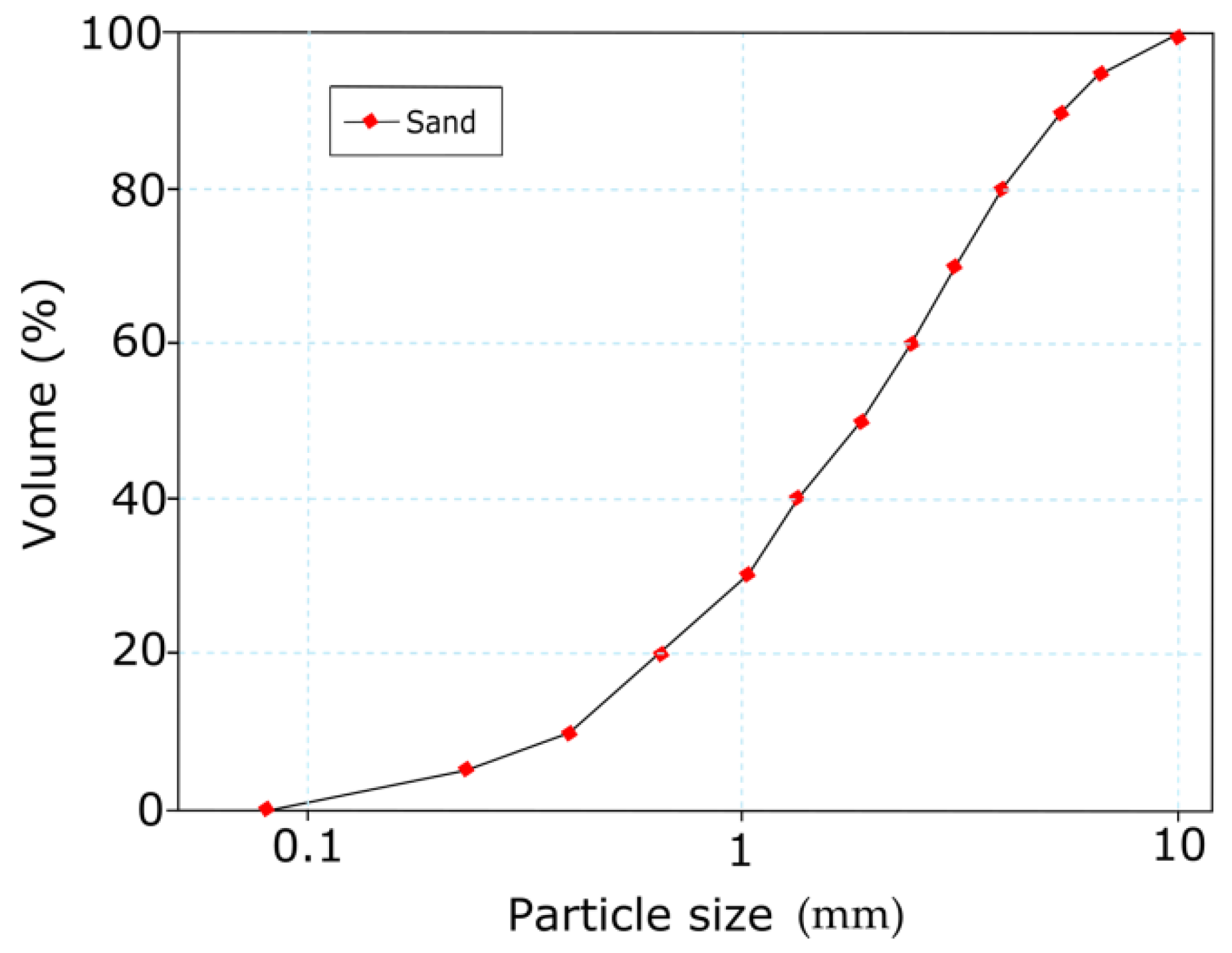

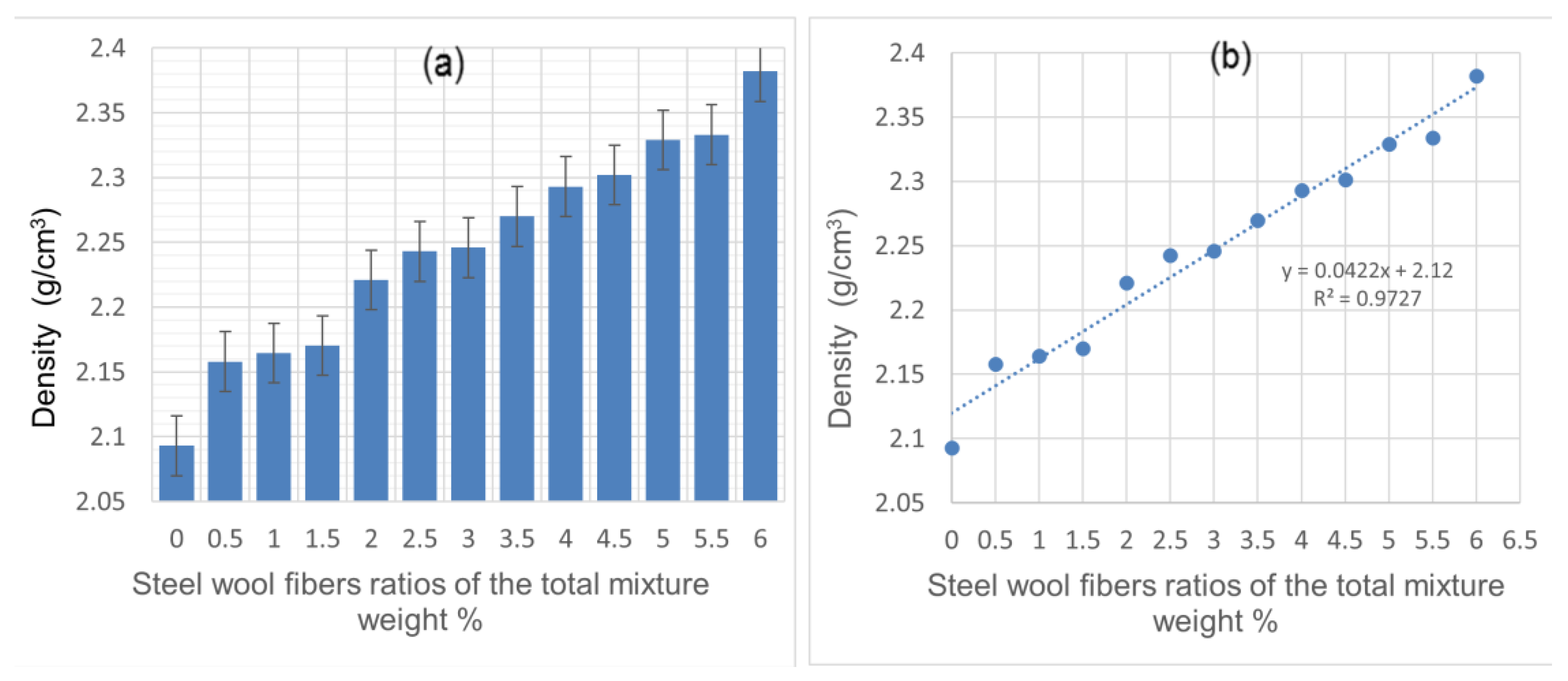
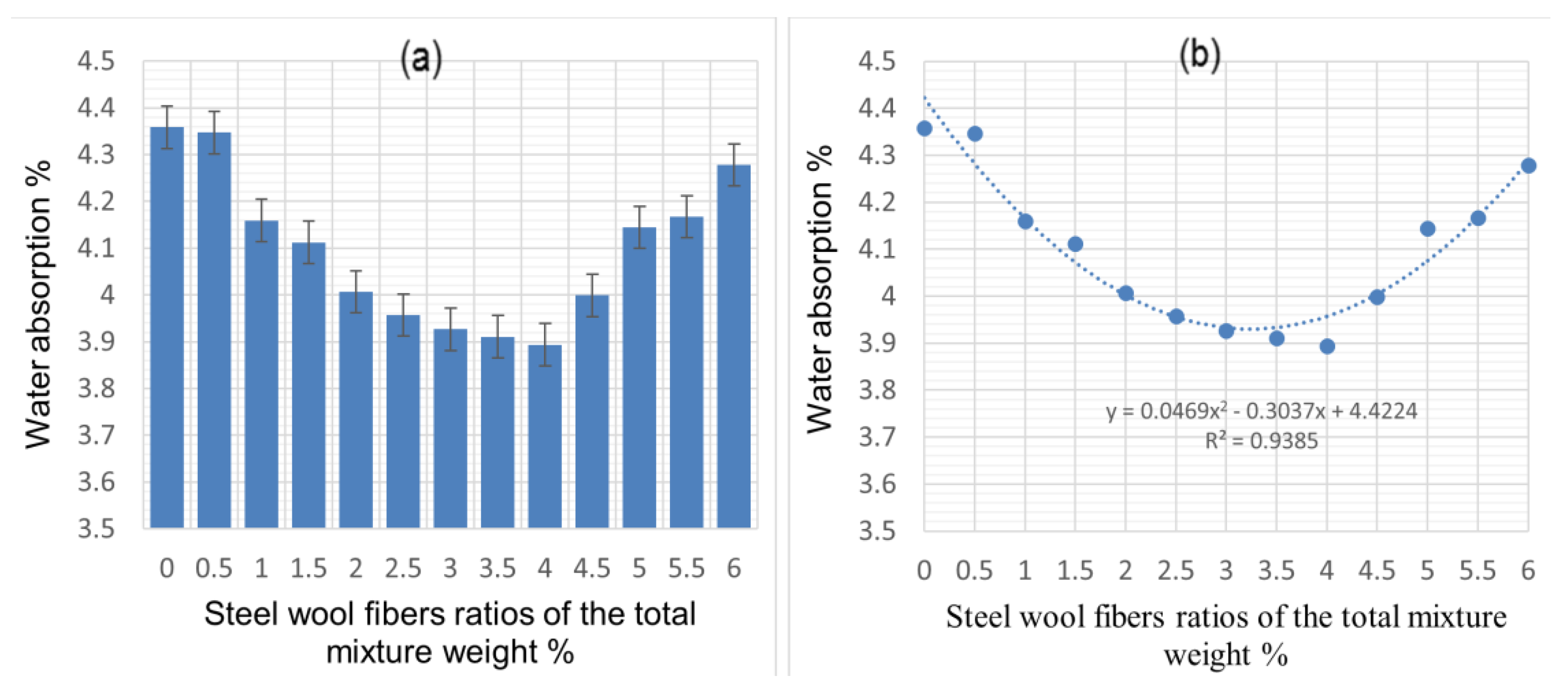
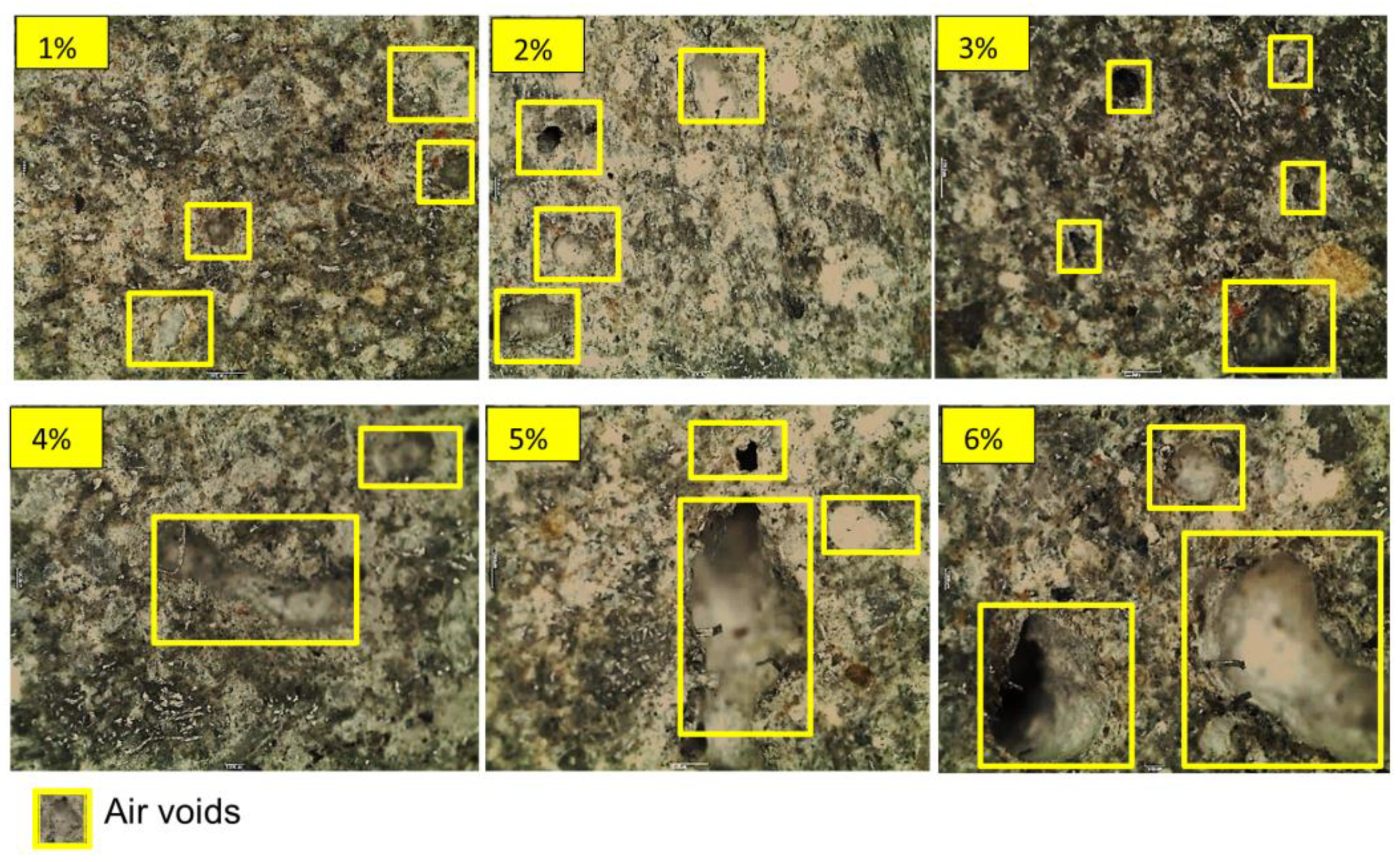
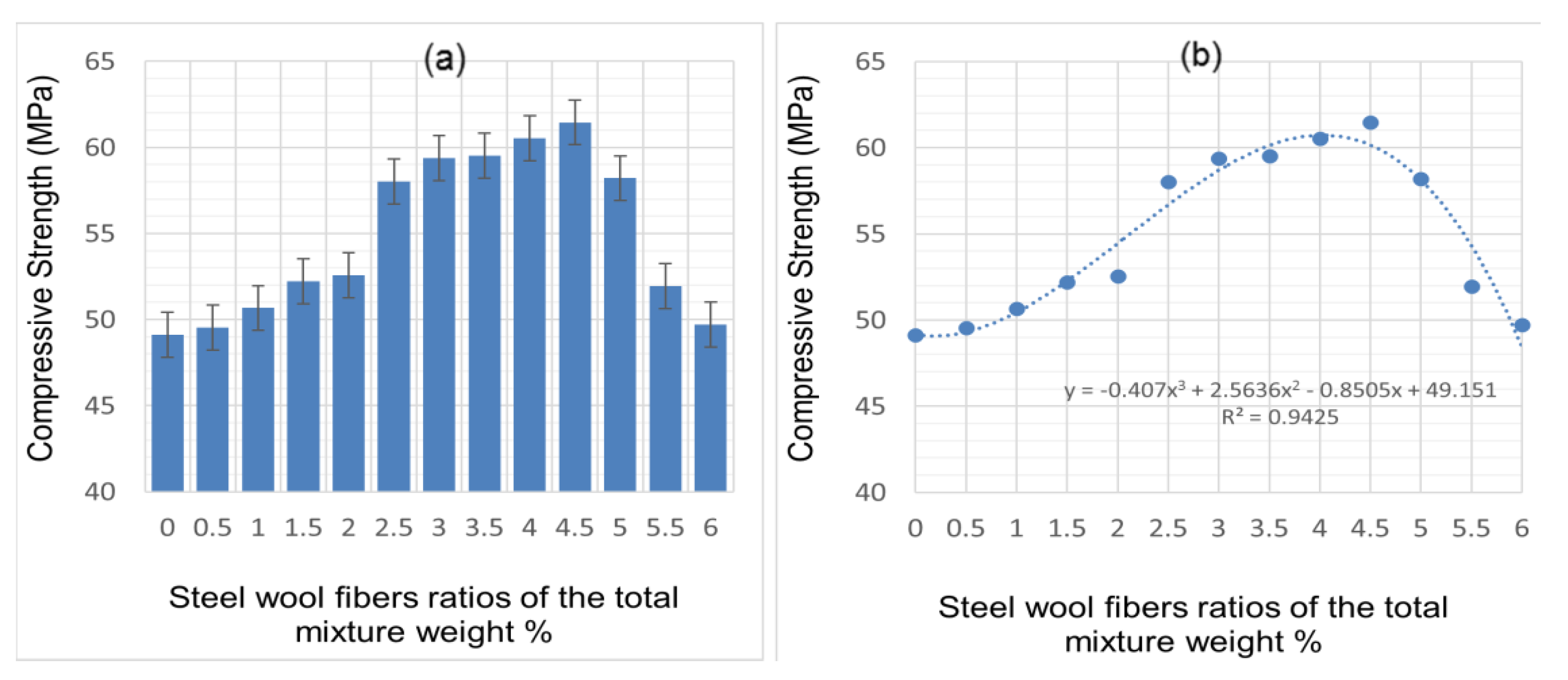
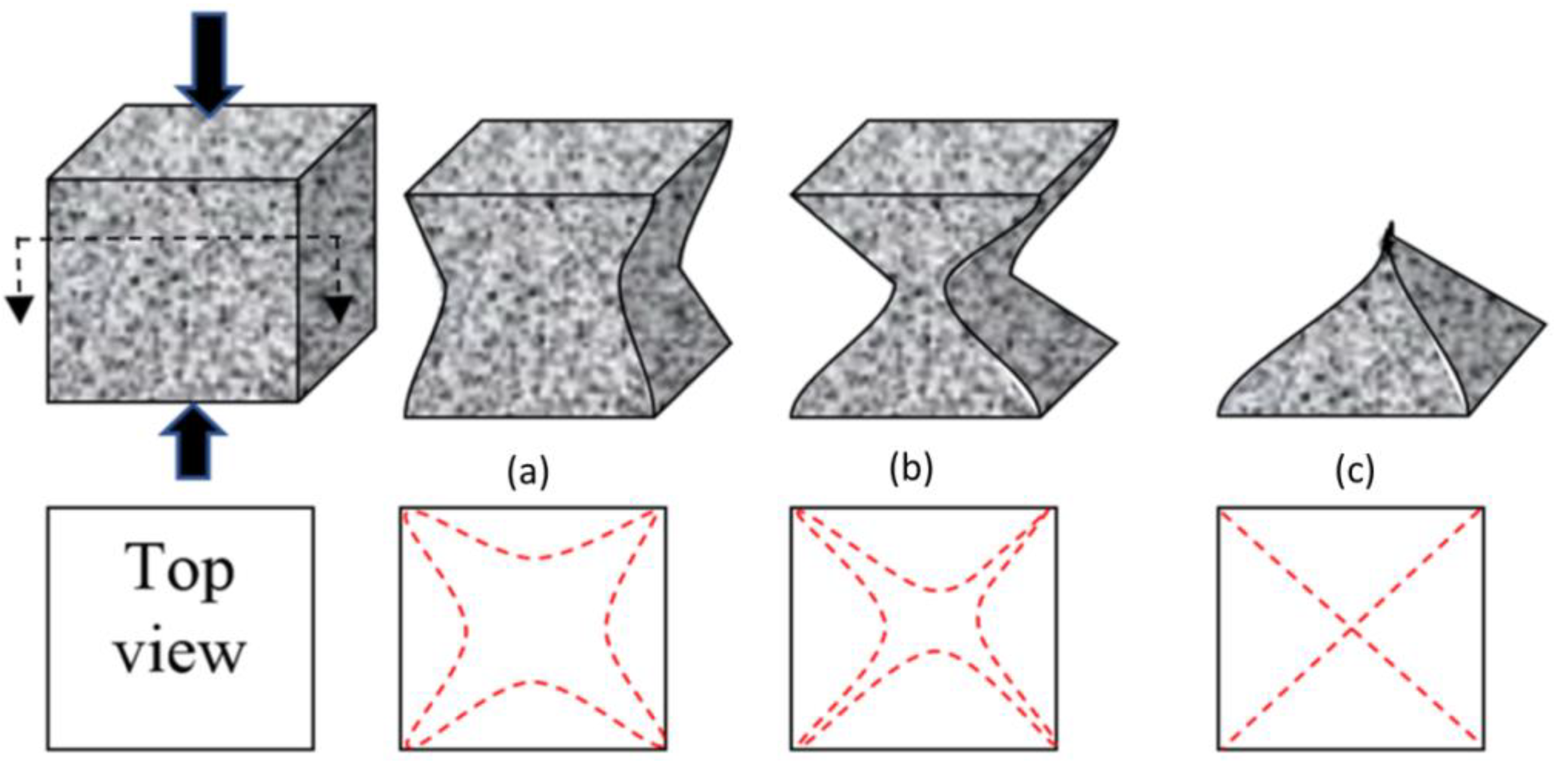
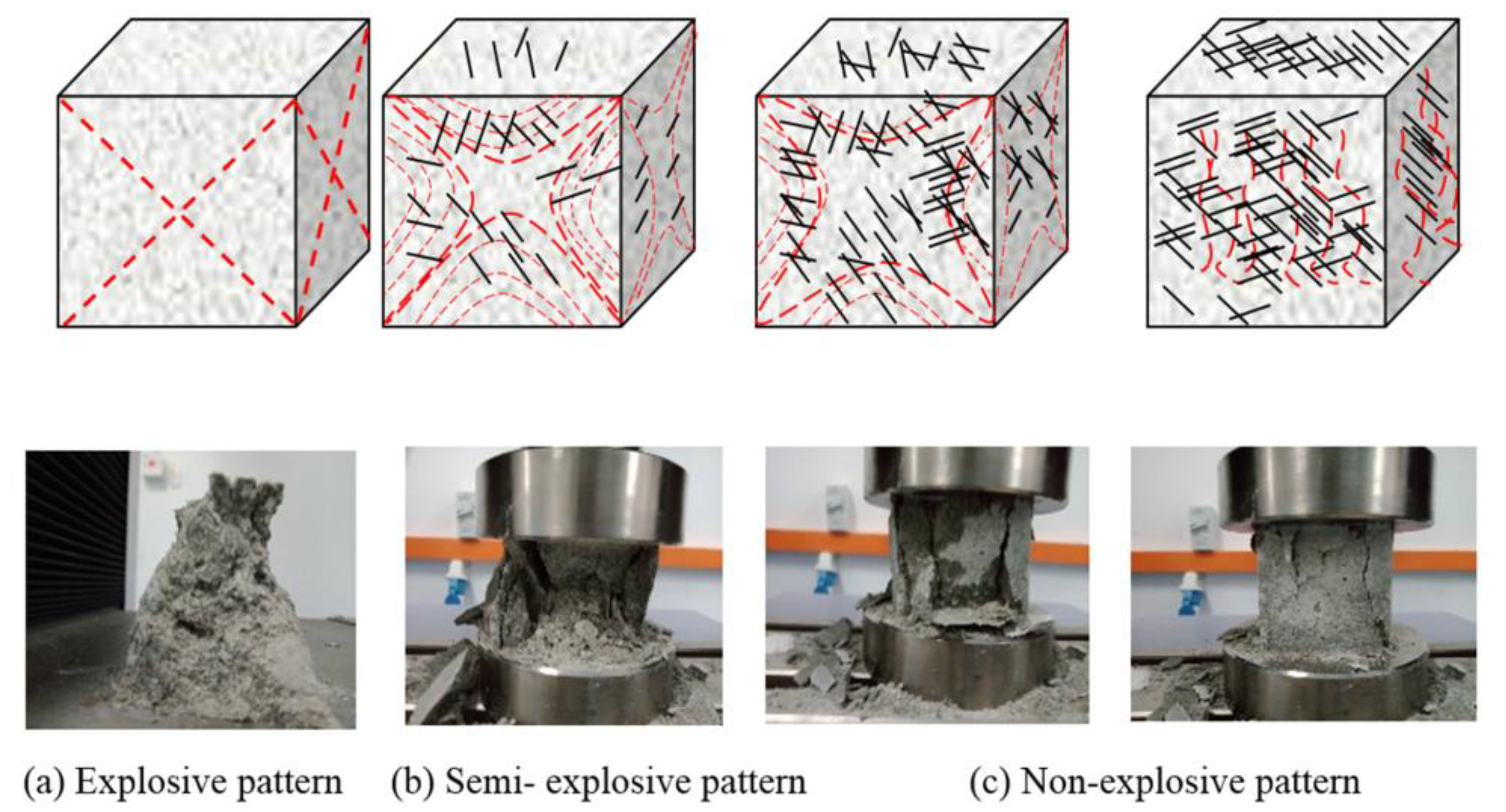
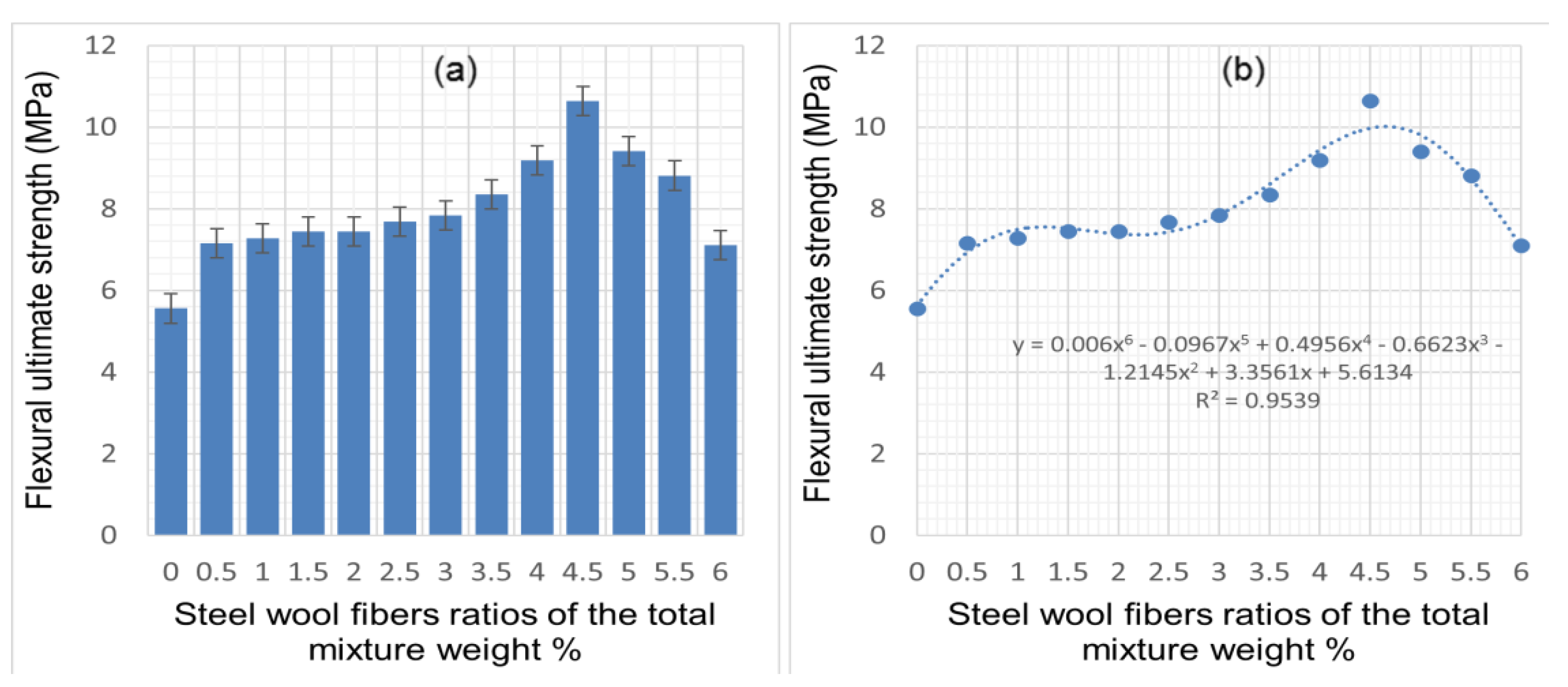
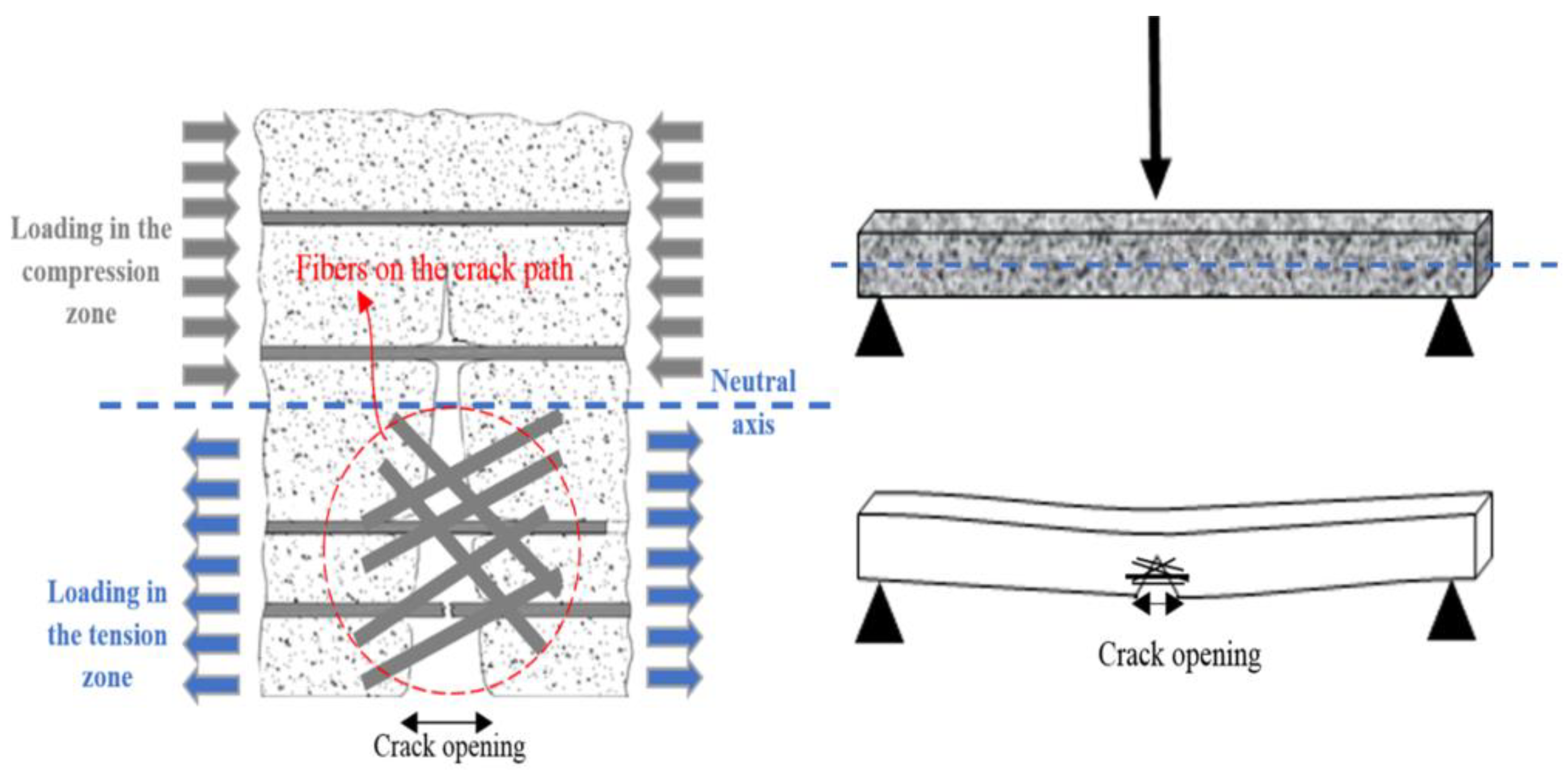

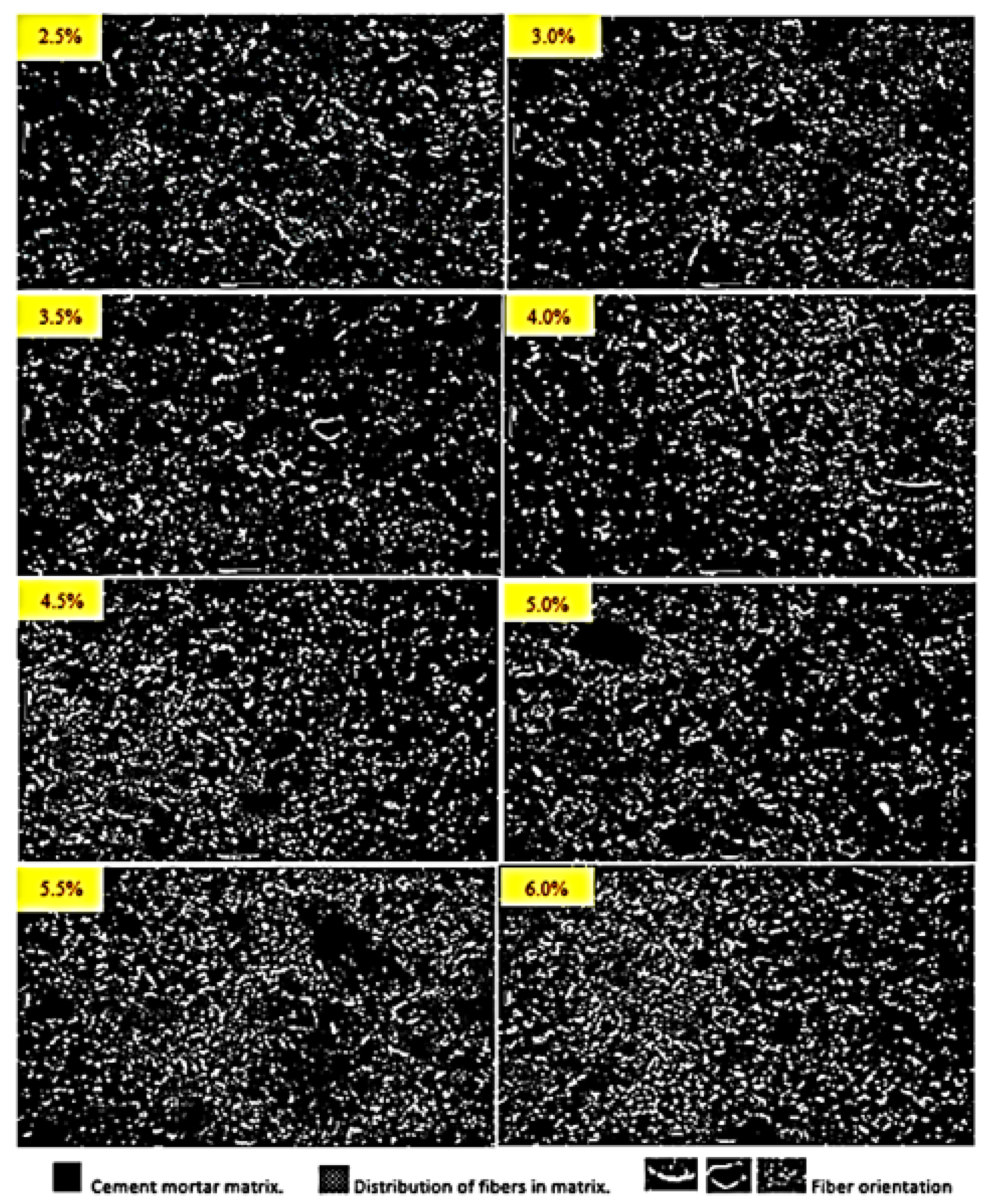
| Author | Types of Concrete | Steel Fibers Type | SF% | Flexural Strength (MPa) 28 days | Compressive Strength (MPa) 28 days | ||
|---|---|---|---|---|---|---|---|
| with SF | without | with SF | without | ||||
| Aldikheeli & Shubber, 2020 [12] | Cement-based | hooked-end length of 35 mm, diameter of 0.55 mm | 1.50 | 4.40 | 4.20 | 31.46 | 26.00 |
| hooked-end length of 60 mm, diameter of 0.90 mm | 1.50 | 6.90 | 4.20 | 30.00 | 26.00 | ||
| Zinkaah, 2014 [13] | Cement-based | Straight length of 15 mm, diameter of 0.2 mm | 1.00 | 10.18 | 6.60 | 38.80 | 29.77 |
| Jhatial et al., 2018 [14] | Normal concrete (M20), OPC | Hooked-end length of 25 mm, diameter of 0.5 mm | 3.00 | 6.16 | 4.09 | 31.46 | 26.60 |
| Iqbal et al., 2015 [15] | Cement-based | Straight length of 13 mm, diameter of 0.2 mm | 1.25 | 7.62 | - | 59.74 | - |
| Mahadik et al., 2014 [16] | Normal concrete (M40), OPC | Straight length of 60 mm, diameter of 0.75 mm | 0.75 | 6.62 | 4.62 | 51.45 | 41.42 |
| Physical Properties | ||||
| Specific Gravity | Blaine (cm2/g) | Setting Time (min) | Loss on Ignition (%) | |
| Initial | Final | |||
| 3.15 | 4022 | 136 | 190 | 3.3 |
| Chemical Composition (%) | ||||
| CaO | SiO2 | Al2O3 | SO3 | Fe2O3 |
| 70 | 17 | 3.9 | 3.6 | 3.2 |
| Specifications | Chopped Steel Wool Fibers |
|---|---|
| Length and diameter | 4 mm (max) and 25 µm (max) |
| Specific gravity | 7800 kg/m3 |
| Tensile strength | 966–1242 MPa |
| Young’s modulus | 200–210 GPa |
Publisher’s Note: MDPI stays neutral with regard to jurisdictional claims in published maps and institutional affiliations. |
© 2021 by the authors. Licensee MDPI, Basel, Switzerland. This article is an open access article distributed under the terms and conditions of the Creative Commons Attribution (CC BY) license (http://creativecommons.org/licenses/by/4.0/).
Share and Cite
Amer, A.A.R.; Abdullah, M.M.A.B.; Liew, Y.M.; A Aziz, I.H.; Wysłocki, J.J.; Tahir, M.F.M.; Sochacki, W.; Garus, S.; Gondro, J.; Amer, H.A.R. Optimizing of the Cementitious Composite Matrix by Addition of Steel Wool Fibers (Chopped) Based on Physical and Mechanical Analysis. Materials 2021, 14, 1094. https://doi.org/10.3390/ma14051094
Amer AAR, Abdullah MMAB, Liew YM, A Aziz IH, Wysłocki JJ, Tahir MFM, Sochacki W, Garus S, Gondro J, Amer HAR. Optimizing of the Cementitious Composite Matrix by Addition of Steel Wool Fibers (Chopped) Based on Physical and Mechanical Analysis. Materials. 2021; 14(5):1094. https://doi.org/10.3390/ma14051094
Chicago/Turabian StyleAmer, Akrm A Rmdan, Mohd Mustafa Al Bakri Abdullah, Yun Ming Liew, Ikmal Hakem A Aziz, Jerzy J. Wysłocki, Muhammad Faheem Mohd Tahir, Wojciech Sochacki, Sebastian Garus, Joanna Gondro, and Hetham A. R. Amer. 2021. "Optimizing of the Cementitious Composite Matrix by Addition of Steel Wool Fibers (Chopped) Based on Physical and Mechanical Analysis" Materials 14, no. 5: 1094. https://doi.org/10.3390/ma14051094
APA StyleAmer, A. A. R., Abdullah, M. M. A. B., Liew, Y. M., A Aziz, I. H., Wysłocki, J. J., Tahir, M. F. M., Sochacki, W., Garus, S., Gondro, J., & Amer, H. A. R. (2021). Optimizing of the Cementitious Composite Matrix by Addition of Steel Wool Fibers (Chopped) Based on Physical and Mechanical Analysis. Materials, 14(5), 1094. https://doi.org/10.3390/ma14051094










